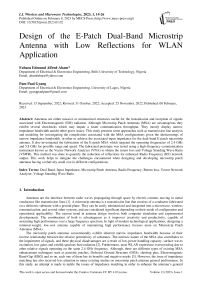Design of the E-Patch Dual-Band Microstrip Antenna with Low Reflections for WLAN Application
Автор: Fubara Edmund Alfred-Abam, Pam Paul Gyang
Журнал: International Journal of Wireless and Microwave Technologies @ijwmt
Статья в выпуске: 1 Vol.13, 2023 года.
Бесплатный доступ
Antennas are either massive or miniaturized structures useful for the transmission and reception of signals associated with Electromagnetic (EM) radiation. Although Microstrip Patch Antennas (MSA) are advantageous they exhibit several drawbacks which may impair a faster communication throughput. They mostly display narrow impedance bandwidth amidst other grave issues. This study presents some approaches such as transmission line analysis and modeling for investigating the complexities associated with the MSA configurations given the shortcomings of narrow impedance bandwidth. in other to achieve the associated input impedance for the dual-band E-patch microstrip antenna. It also investigated the fabrication of the E-patch MSA which targeted the operating frequencies of 2.4 GHz and 5.8 GHz for possible range and speed. The fabricated prototype was tested using a high-frequency communication instrument known as the Vector Network Analyzer (VNA) to obtain the return loss and Voltage Standing Wave Ratio (VSWR). This method was done to quantify the reduction of reflections for enhanced Radio Frequency (RF) network output. This work helps to mitigate the challenges encountered when designing and developing microstrip patch antennas having a relatively small size in different configurations.
Dual Band, Input Impedance, Microstrip Patch Antenna, Radio Frequency, Return loss, Vector Network Analyzer, Voltage Standing Wave Ratio
Короткий адрес: https://sciup.org/15019200
IDR: 15019200 | DOI: 10.5815/ijwmt.2023.01.02
Список литературы Design of the E-Patch Dual-Band Microstrip Antenna with Low Reflections for WLAN Application
- Sharma, N and Vipul, S (2017). A Journal of Antenna Dipole to Fractal. Journal of Engineering and Technology. 6(2): 317-351.
- Abdullahi, S.B.M. Shahanawaz, K. Ain M.F. and Zainal. A.A. (2019). Microstrip Patch Antenna: A Review and the Current State of the Art. Journal of Advanced Research in Dynamical and Control Systems. 11(7): 510-524.
- Alok, K. Nancy, G. and Gautam, P.C, (2016). Gain and Bandwidth Enhancement Techniques in Microstrip Patch Antennas – A Review. International Journal of Computer Application. 148(7): 9-14.
- Oke, M.O. (2017). An Analytical Method for Solving Wave Equations on Transmission Lines. International Journal of Mathematics and Statistics Studies. 5(3): 28-35.
- Hasirci, Z. Cavdar, I.H. and Ozturk, M. (2018). RLGC(f) Modeling of a Busbar Distribution System via Measured S parameters at CENELEC and FCC bands. Turkish Journal of Electrical Engineering and Computer Science. 26(1): 489-500.
- Unni, N.S. and Soumya, A.M. (2016). Transmission Line Characteristics. IOSR Journal of Electronics and Communication Engineering, 3(5): 67-77.
- Carr, J.J. (2001). Practical Antenna Handbook, Fourth Edition. MacGraw-Hill. United States of America.
- Rouphael, T. J. (2014). Wireless Receiver Architectures and Design. Antenna, RF, Synthesizer, Mixed Signal, and Digital Signal Processing. 1st Edition.
- Ali, E. Khaled, E. and Hassan, B. (2012). Input Impedance, VSWR and Return Loss of a Conformal Microstrip Printed Antenna for TM01 Mode using Two Different Substrates. International Journal for Networks and Communications. 2(2): 13-19.
- Garima, K. A. and Khanna R. (2013). Dual and Triple Band U-Slot Microstrip Patch Antenna for WLAN Applications, International Journal of Advanced Research in Computer and Communication Engineering. 2(5): 2201-2204.
- Tumsara, K.V. and Zade, P.L. (2016). Microstrip Antenna using EBG Substrate, International Journal on Recent and Innovation Trends in Computing and Communication. 7(8): 1573- 1577.
- Sastry, I.V.S.R. and Sankar, K.J. (2014). Proximity Coupled Rectangular Microstrip Antenna with X-slot for WLAN Application. Global Journal of Researches in Engineering: Electrical and Electronics Engineering. 14(1):1-5.
- Magaji, Y.R. Sulaiman, Y.Y. Babangida, M.M. Mustapha M.G.and Muhammad, S.A, (2018). Design of Microstrip Patch Antenna for Future 5G Applications. International Journal of Advanced Academic Research Sciences, Technology and Engineering. 4(7): 9-20.
- Kaur, P. Singh, G. Jaspal, S. and Manjit, K. (2016). Design and Development of Symmetrical E-shaped Microstrip Patch Antenna for Multiband Wireless Applications. International Journal of Signal Processing Image Processing and Pattern Recognition. 9(10): 405-416.
- Sharma, P. and Yadava, R.L. (2014). Comparative Analysis of Feeding Techniques for Microstrip Patch Antenna and Smart Antenna Applications in Mobile Communication. IOSR Journal of Electronics and Communication Engineering (IOSR-JECE). 9(3): 25-30.
- Balanis, A.C. (2005). Antenna Theory, Analysis and Design. Third Edition, New Jersey, Hoboken. John Wiley & Sons, Inc.
- Sharma, S. Tripathi, C.C. and Rishi, R. (2017). Impedance Matching Techniques for Microstrip Patch Antennas. Indian Journal of Science and Technology, 10(28): 1-16.
- Jasim, S.E. Jusoh, M.H. Mazwir, M.H. and Mahud, S.N.S. (2015). Finding the Best Feeding Point Location of Patch Antenna using HFSS. ARPN Journal of Engineering and Applied Sciences. 10(23): 17444-17449.
- Base Station Transmits (2015). Method to Maintain Cable and Antenna Systems for Healthy Network Performance.[Online]Available :https://anritsu.typepad.com/basestationtransmits/2015/06/methods-to-maintain-cable-and-antenna-systems-for-healthy-network-performance.html.
- Tong, T.C. (1973). Electromagnetic Scattering by a Thin Wire with Continuous Impedance Loading; Part II: Time Domain Analysis. Electromagnetics Division Institute for Basic Standards National Bureau of Standards Boulder, Colorado 80302.


